Resonantly Forced Baroclinic Waves in the Oceans: A New Approach to Climate Variability
Abstract
:1. Introduction
1.1. Background
1.1.1. The Mid-Pleistocene Transition (MPT)
1.1.2. Long-Term Evolution of the El Niño–Southern Oscillation (ENSO)
1.2. Related Work
1.2.1. Short Period Rossby Waves
1.2.2. Analogy between Short Period Rossby Waves and Gyral Rossby Waves
1.2.3. Properties of GRWs
- (1)
- The progressive GRW must wind an integer number of turns around the gyre, over a half-wavelength. In this way the modulated polar and radial currents allow the warm water to accumulate around the gyre for a half-period, then to evacuate to the pole via the drift current (the circumpolar current in the southern hemisphere) during the following half-period.
- (2)
- GRWs do not dampen as their period increases because Rayleigh friction is compensated by the lengthening of the forcing duration. So, in theory, the periods of GRWs have no upper limit. Therefore, multi-frequency GRWs overlap, behaving as coupled oscillators because they share the same modulated polar and radial currents. Applied to the modulated currents of the subtropical gyres, the equations of motion of coupled oscillators with inertia require that GRWs are subharmonics of annual Rossby waves. Subharmonic modes ensure the durability of the resonant dissipative system, with each oscillator transferring as much interaction energy to all the others that it receives periodically [36]. Here the Caldirola–Kanai equation is used as the prototype of the equations of motion. It specifies how GRWs are resonantly forced by solar and orbital cycles in subharmonic modes. The natural period of the oscillator is an integer number of years deduced by recurrence: with = 1 year, = 2 or 3 to ensure the stability of the gyres. Measurement of the apparent eastward velocity of 8-year period Rossby waves from their western antinodes (from where the western boundary currents leave the continents) allows estimating the time they would take to propagate all around the gyres (the phase velocity of long-period Rossby waves depends on the latitude of the centroid of the gyre, not on the period). Knowing that the very existence of such waves supposes that their period is a subharmonic of the fundamental wave, whose period is exactly one year as a result of the declination of the Sun, the time required to propagate around the gyre is 64 years for the North and South Atlantic, 128 years for the North and South Pacific and 32 years for the South Indian Ocean. It is convenient to deduce the period from the subharmonic modes using the North Atlantic as a reference. The first subharmonic mode being = the corresponding period is . Conversely, for a natural period , the number of turns traveled in the North Atlantic is . This also applies to the South Atlantic, but the number of turns is twice less in the North and South Pacific and twice more in the Southern Indian Ocean.
- (3)
- When the forcing period is close to the natural period of a GRW, a fine tuning occurs, resulting from increasing/decreasing of the mean radius of the gyre.
- (4)
- In the absence of the positive feedback resulting from the temperature gradient between the low and high latitudes of the gyres, the radial current ν would be in phase with solar irradiance (ν is positive outwardly of the gyre), the surface height perturbation η would be in quadrature with solar irradiance as well as the polar current υ (υ is positive when it is anti-cyclonic). The positive feedback has the effect of advancing the phase of GRWs by about a quarter of a period so that both the thermocline depth and the polar current velocity are nearly in phase with the forcing.
1.2.4. Subharmonic Modes
1.2.5. ENSO and the Equatorial Pacific
2. New Clues in Favor of the Mediation of GRWs
- to extend the list of subharmonic modes in [45] to periods longer than 98.3 Ka while specifying the resonant nature of GRWs and their effects on climate. Taking advantage of the alkenone paleothermometer in sediment cores sampled in the Tasman Sea floor, we will show that, in the same way as during the MPT, but with periods 10 times longer, a transition occurred at the hinge of Pliocene-Pleistocene. Both transitions as well as the observed adjustment of the South Pacific gyre to the resonance conditions during the MPT will be interpreted as the response to orbital forcing of the climate system with the mediation of GRWs.
- to find the driver of long-term ENSO evolution. Taking advantage of data set of individual Globigerinoides ruber spanning the Holocene and the Last Glacial Maximum from sediment core in the eastern equatorial Pacific, we will show how the ENSO activity is modulated according to subharmonic modes.
3. Materials and Methods
3.1. Sea Surface Temperatures at Deep Sea Drilling Project (DSDP) Site 593 and ODP Site 1172
3.2. Temperatures at DSDP Site 593 Compared to EPICA Data
3.3. Variability of Individual Globigerinoides Ruber at Site V21–30
3.4. Data
3.5. Filtering
4. Results and Discussion
4.1. The South Pacific Subtropical Gyre during the MPT
4.2. Subharmonic Modes
4.3. The Band 295–590 Ka
4.4. The Band 590–1769 Ka
4.5. The Band 1769–3539 Ka
4.6. The Mid-Pleistocene and Pliocene-Pleistocene Transitions
4.7. Long-Term Evolution of ENSO
4.7.1. Standard Deviation of in Individual Globigerinoides ruber
4.7.2. Hydrological Processes
5. Conclusions
- (1)
- The poleward drift of the subtropical front of 4° during the MPT highlights an adjustment of the gyre to tune to the forcing period (~41 Ka) before the MPT while the subharmonic mode was dominant. After the MPT the subharmonic mode becomes dominant while its natural period approaches the forcing period (~100 Ka). An increase in the circumference of the gyre of almost 20% without displacement of the centroid allows the subharmonic mode to be tuned to the new forcing period while the natural period that characterizes the subharmonic mode is regained.
- (2)
- Thanks to the high resolution of the climate archive which spans 3.5 million years, the alkenone concentration at DSDP Site 593 presently situated north of the subtropical front allows to extend subharmonic modes beyond up to (Table 1). It is shown that modes and are subject to eccentricity forcing while modes and are pure subharmonics.
- (3)
- A transition of the dominant mode between two consecutive subharmonic modes occurs at the Pliocene-Pleistocene hinge. Like what happens during the MPT, the two subharmonic modes are forced simultaneously, and the natural period of the highest mode optimally tunes to the forcing period when both become very close.
- (4)
- Variability of ENSO activity during the Holocene and the Last Glacial Maximum is subject to long-term adjustment of geostrophic forces in the equatorial Pacific. It is the amplitude of variation of the depth of the thermocline in the central and eastern Pacific which evolutes according to the subharmonic mode whose resonant period is 24.6 Ka, and not, as often stated, the frequency of events which occur on average every 4 years. This frequency is immutable, being intimately linked to the dynamics of the equatorial Pacific. Here again, the variability of ENSO during the Holocene and since 1870 is subject to the adjustment of geostrophic forces in the equatorial Pacific according to the subharmonic modes, in the first case (the resonant period is 3.1 Ka), and in the second (the resonant period is 64 years). Periods of warming induce a decrease in ENSO activity.
Funding
Acknowledgments
Conflicts of Interest
References
- Hays, J.D.; Imbrie, J.; Shackleton, N.J. Variations in the Earth’s Orbit: Pacemaker of the Ice Ages. Science 1976, 194, 1121–1132. [Google Scholar] [CrossRef]
- Rial, J.; Anaclerio, C. Understanding nonlinear responses of the climate system to orbital forcing. Quat. Sci. Rev. 2000, 19, 1709–1722. [Google Scholar] [CrossRef]
- Hasselmann, K. Stochastic climate models Part I. Theory. Tellus 1976, 28, 473–485. [Google Scholar] [CrossRef] [Green Version]
- Benzi, R.; Parisi, G.; Sutera, A.; Vulpiani, A. Stochastic resonance in climatic change. Tellus 1982, 34, 10–15. [Google Scholar] [CrossRef]
- Nicolis, C. Stochastic aspects of climatic transitions—response to a periodic forcing. Tellus 1982, 34, 1–9. [Google Scholar] [CrossRef]
- Matteucci, G. A study of the climatic regimes of the Pleistocene using a stochastic resonance model. Clim. Dyn. 1991, 6, 67–81. [Google Scholar] [CrossRef]
- Nyman, K.H.M.; Ditlevsen, P.D. The middle Pleistocene transition by frequency locking and slow ramping of internal period. Clim. Dyn. 2019, 53, 3023–3038. [Google Scholar] [CrossRef] [Green Version]
- Ashwin, P.; Ditlevsen, P. The middle Pleistocene transition as a generic bifurcation on a slow manifold. Clim. Dyn. 2015, 45, 2683–2695. [Google Scholar] [CrossRef] [Green Version]
- Ditlevsen, P.D. Bifurcation structure and noise-assisted transitions in the Pleistocene glacial cycles. Paleoceanography 2009, 24. [Google Scholar] [CrossRef] [Green Version]
- Frankignoul, C.; Hasselmann, K. Stochastic climate models, Part II Application to sea-surface temperature anomalies and thermocline variability. Tellus 1977, 29, 289–305. [Google Scholar] [CrossRef] [Green Version]
- Saravanan, R.; McWilliams, J.C. Stochasticity and Spatial Resonance in Interdecadal Climate Fluctuations. J. Clim. 1997, 10, 2299–2320. [Google Scholar] [CrossRef]
- Sergin, V. Origin and Mechanism of Large-Scale Climatic Oscillations. Science 1980, 209, 1477–1482. [Google Scholar] [CrossRef] [PubMed]
- Ganopolski, A.; Rahmstorf, S. Abrupt Glacial Climate Changes due to Stochastic Resonance. Phys. Rev. Lett. 2002, 88, 038501. [Google Scholar] [CrossRef] [PubMed] [Green Version]
- Timmermann, A.; Gildor, H.; Schulz, M.; Tziperman, E. Coherent Resonant Millennial-Scale Climate Oscillations Triggered by Massive Meltwater Pulses. J. Clim. 2003, 16, 2569–2585. [Google Scholar] [CrossRef] [Green Version]
- Elderfield, H.; Ferretti, P.; Greaves, M.; Crowhurst, S.J.; McCave, I.N.; Hodell, D.A.; Piotrowski, A.M. Evolution of Ocean Temperature and Ice Volume Through the Mid-Pleistocene Climate Transition. Science 2012, 337, 704–709. [Google Scholar] [CrossRef]
- Mudelsee, M.; Schulz, M. The Mid-Pleistocene climate transition: Onset of 100 ka cycle lags ice volume build-up by 280 ka. Earth Planet. Sci. Lett. 1997, 151, 117–123. [Google Scholar] [CrossRef]
- Tziperman, E.; Gildor, H. On the mid-Pleistocene transition to 100-kyr glacial cycles and the asymmetry between glaciation and deglaciation times. Paleoceanography 2003, 18, 1. [Google Scholar] [CrossRef]
- Clark, P.U.; Archer, D.W.; Pollard, D.; Blum, J.D.; Rial, J.A.; Brovkin, V.; Mix, A.C.; Pisias, N.G.; Roy, M. The middle Pleistocene transition: Characteristics, mechanisms, and implications for long-term changes in atmospheric pCO2. Quat. Sci. Rev. 2006, 25, 3150–3184. [Google Scholar] [CrossRef] [Green Version]
- Chalk, T.B.; Hain, M.P.; Foster, G.L.; Rohling, E.J.; Sexton, P.F.; Badger, M.P.S.; Cherry, S.G.; Hasenfratz, A.P.; Haug, G.H.; Jaccard, S.L.; et al. Causes of ice age intensification across the Mid-Pleistocene Transition. Proc. Natl. Acad. Sci. USA 2017, 114, 13114–13119. [Google Scholar] [CrossRef] [Green Version]
- Hönisch, B.; Hemming, N.G.; Archer, D.; Siddall, M.; McManus, J.F. Atmospheric Carbon Dioxide Concentration across the Mid-Pleistocene Transition. Science 2009, 324, 1551–1554. [Google Scholar] [CrossRef]
- Quinn, C.; Sieber, J.; Von Der Heydt, A.S.; Lenton, T.M. The Mid-Pleistocene Transition induced by delayed feedback and bistability. Dyn. Stat. Clim. Syst. 2018, 3, 1–17. [Google Scholar] [CrossRef]
- Willeit, M.; Ganopolski, A.; Calov, R.; Brovkin, V. Mid-Pleistocene transition in glacial cycles explained by declining CO2and regolith removal. Sci. Adv. 2019, 5, eaav7337. [Google Scholar] [CrossRef] [PubMed] [Green Version]
- Lu, Z.; Liu, Z. Examining El Niño in the Holocene: Implications and challenges. Natl. Sci. Rev. 2018, 5, 807–809. [Google Scholar] [CrossRef]
- Tudhope, A.W.; Chilcott, C.P.; McCulloch, M.T.; Cook, E.R.; Chappell, J.; Ellam, R.M.; Lea, D.W.; Lough, J.M.; Shimmield, G.B. Variability in the El Nino-Southern Oscillation Through a Glacial-Interglacial Cycle. Science 2001, 291, 1511–1517. [Google Scholar] [CrossRef] [PubMed]
- McGregor, H.; Gagan, M.K. Western Pacific coral δ18O records of anomalous Holocene variability in the El Niño-Southern Oscillation. Geophys. Res. Lett. 2004, 31. [Google Scholar] [CrossRef] [Green Version]
- Cobb, K.M.; Charles, C.D.; Cheng, H.; Edwards, R.L. El Niño/Southern Oscillation and tropical Pacific climate during the last millennium. Nat. Cell Biol. 2003, 424, 271–276. [Google Scholar] [CrossRef]
- Cobb, K.M.; Westphal, N.; Sayani, H.R.; Watson, J.T.; Di Lorenzo, E.; Cheng, H.; Edwards, R.L.; Charles, C.D. Highly Variable El Niño–Southern Oscillation Throughout the Holocene. Science 2013, 339, 67–70. [Google Scholar] [CrossRef] [Green Version]
- Emile-Geay, J.; Cobb, K.M.; Carré, M.; Braconnot, P.; Leloup, J.; Zhou, Y.; Harrison, S.P.; Correge, T.; McGregor, H.V.; Collins, M.; et al. Links between tropical Pacific seasonal, interannual and orbital variability during the Holocene. Nat. Geosci. 2016, 9, 168–173. [Google Scholar] [CrossRef] [Green Version]
- Komugabe-Dixson, A.F.; Fallon, S.J.; Eggins, S.M.; Thresher, R.E. Radiocarbon evidence for mid-late Holocene changes in southwest Pacific Ocean circulation. Paleoceanography 2016, 31, 971–985. [Google Scholar] [CrossRef]
- Zhang, Z.; LeDuc, G.; Sachs, J.P. El Niño evolution during the Holocene revealed by a biomarker rain gauge in the Galápagos Islands. Earth Planet. Sci. Lett. 2014, 404, 420–434. [Google Scholar] [CrossRef] [Green Version]
- Grelaud, M.; Beaufort, L.; Cuven, S.; Buchet, N. Glacial to interglacial primary production and El Niño-Southern Oscillation dynamics inferred from coccolithophores of the Santa Barbara Basin. Paleoceanography 2009, 24, 1203. [Google Scholar] [CrossRef]
- Barr, C.; Tibby, J.; Leng, M.J.; Tyler, J.J.; Henderson, A.C.G.; Overpeck, J.T.; Simpson, G.L.; Cole, J.E.; Phipps, S.J.; Marshall, J.C.; et al. Holocene El Niño–Southern Oscillation variability reflected in subtropical Australian precipitation. Sci. Rep. 2019, 9, 1–9. [Google Scholar] [CrossRef] [PubMed]
- Koutavas, A.; Demenocal, P.B.; Olive, G.C.; Lynch-Stieglitz, J. Mid-Holocene El Niño–Southern Oscillation (ENSO) attenuation revealed by individual foraminifera in eastern tropical Pacific sediments. Geology 2006, 34, 993. [Google Scholar] [CrossRef]
- LeDuc, G.; Vidal, L.; Cartapanis, O.; Bard, E. Modes of eastern equatorial Pacific thermocline variability: Implications for ENSO dynamics over the last glacial period. Paleoceanography 2009, 24, 3202. [Google Scholar] [CrossRef]
- Koutavas, A.; Joanides, S. El Niño-Southern Oscillation extrema in the Holocene and Last Glacial Maximum. Paleoceanography 2012, 27, 4208. [Google Scholar] [CrossRef]
- Pinault, J.-L. Resonantly Forced Baroclinic Waves in the Oceans: Subharmonic Modes. J. Mar. Sci. Eng. 2018, 6, 78. [Google Scholar] [CrossRef] [Green Version]
- Explain with Realism Climate Variability. Available online: http://climatorealist.neowordpress.fr/ (accessed on 19 July 2020).
- Pinault, J.-L. Long Wave Resonance in Tropical Oceans and Implications on Climate: The Atlantic Ocean. Pure Appl. Geophys. 2013, 170, 1913–1930. [Google Scholar] [CrossRef]
- Pinault, J.-L. Long Wave Resonance in Tropical Oceans and Implications on Climate: The Pacific Ocean. Pure Appl. Geophys. 2015, 173, 2119–2145. [Google Scholar] [CrossRef]
- Pinault, J.-L. Resonance of baroclinic waves in the tropical oceans: The Indian Ocean and the far western Pacific. Dyn. Atmos. Oceans 2020, 89, 101119. [Google Scholar] [CrossRef]
- Torrence, C.; Compo, G.P. A practical guide for wavelet analysis. Bull. Am. Meteorol. Soc. 1998, 79, 61–78. [Google Scholar] [CrossRef] [Green Version]
- Pinault, J.-L. Anticipation of ENSO: What teach us the resonantly forced baroclinic waves. Geophys. Astrophys. Fluid Dyn. 2016, 110, 518–528. [Google Scholar] [CrossRef]
- Pinault, J.-L. The Anticipation of the ENSO: What Resonantly Forced Baroclinic Waves Can Teach Us (Part II). J. Mar. Sci. Eng. 2018, 6, 63. [Google Scholar] [CrossRef] [Green Version]
- Pinault, J.-L. Modulated Response of Subtropical Gyres: Positive Feedback Loop, Subharmonic Modes, Resonant Solar and Orbital Forcing. J. Mar. Sci. Eng. 2018, 6, 107. [Google Scholar] [CrossRef] [Green Version]
- Pinault, J.-L. Resonant Forcing of the Climate System in Subharmonic Modes. J. Mar. Sci. Eng. 2020, 8, 60. [Google Scholar] [CrossRef] [Green Version]
- McClymont, E.L.; Elmore, A.C.; Kender, S.; Leng, M.J.; Greaves, M.; Elderfield, H. Pliocene-Pleistocene evolution of sea surface and intermediate water temperatures from the southwest Pacific. Paleoceanography 2016, 31, 895–913. [Google Scholar] [CrossRef] [PubMed] [Green Version]
- Ballegeer, A.-M.; Flores, J.A.; Sierro, F.J.; Andersen, N. Monitoring fluctuations of the Subtropical Front in the Tasman Sea between 3.45 and 2.45Ma (ODP site 1172). Palaeogeogr. Palaeoclim. Palaeoecol. 2012, 313–314, 215–224. [Google Scholar] [CrossRef]
- Berger, A.; Loutre, M.-F. Insolation values for the climate of the last 10 million years. Quat. Sci. Rev. 1991, 10, 297–317. [Google Scholar] [CrossRef]
- Zeebe, R.E.; Lourens, L. Solar System chaos and the Paleocene–Eocene boundary age constrained by geology and astronomy. Science 2019, 365, 926–929. [Google Scholar] [CrossRef] [Green Version]
- Grootes, P.M.; Stuiver, M. Oxygen 18/16 variability in Greenland snow and ice with 10−3- to 105-year time resolution. J. Geophys. Res. Space Phys. 1997, 102, 26455–26470. [Google Scholar] [CrossRef]
- Jouzel, J.; Masson-Delmotte, V.; Cattani, O.; Dreyfus, G.; Falourd, S.; Hoffmann, G.; Minster, B.; Nouet, J.; Barnola, J.-M.; Chappellaz, J.; et al. Orbital and Millennial Antarctic Climate Variability over the Past 800,000 Years. Science 2007, 317, 793–796. [Google Scholar] [CrossRef] [Green Version]
- Rayner, N.A.; Parker, D.E.; Horton, E.B.; Folland, C.K.; Alexander, L.V.; Rowell, D.P.; Kent, E.C.; Kaplan, A.L. Global analyses of sea surface temperature, sea ice, and night marine air temperature since the late nineteenth century. J. Geophys. Res. Space Phys. 2003, 108, 4407. [Google Scholar] [CrossRef]
- Pinault, J.-L. Anthropogenic and Natural Radiative Forcing: Positive Feedbacks. J. Mar. Sci. Eng. 2018, 6, 146. [Google Scholar] [CrossRef] [Green Version]
- Pinault, J.-L. The Moist Adiabat, Key of the Climate Response to Anthropogenic Forcing. Climate 2020, 8, 45. [Google Scholar] [CrossRef] [Green Version]

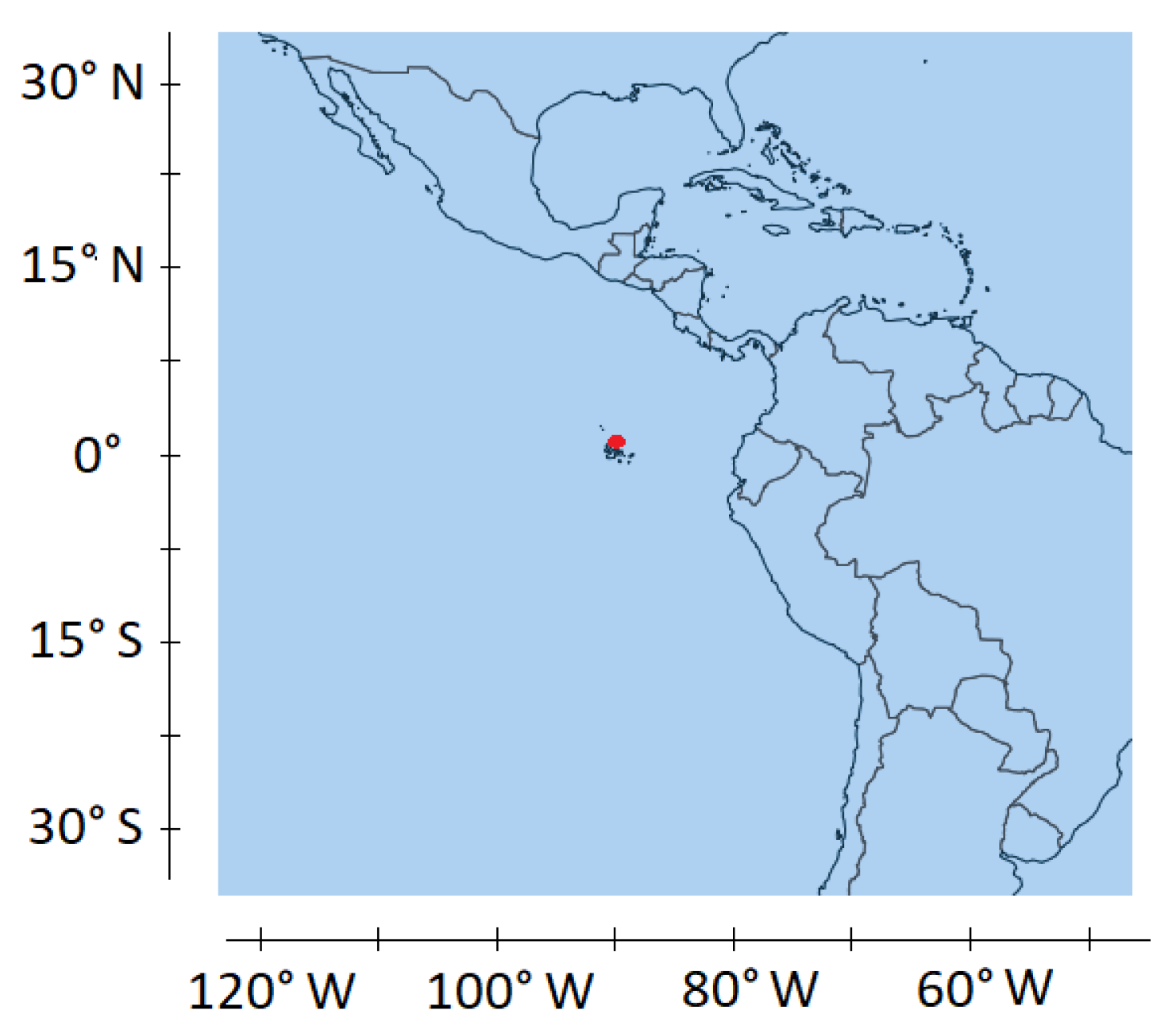
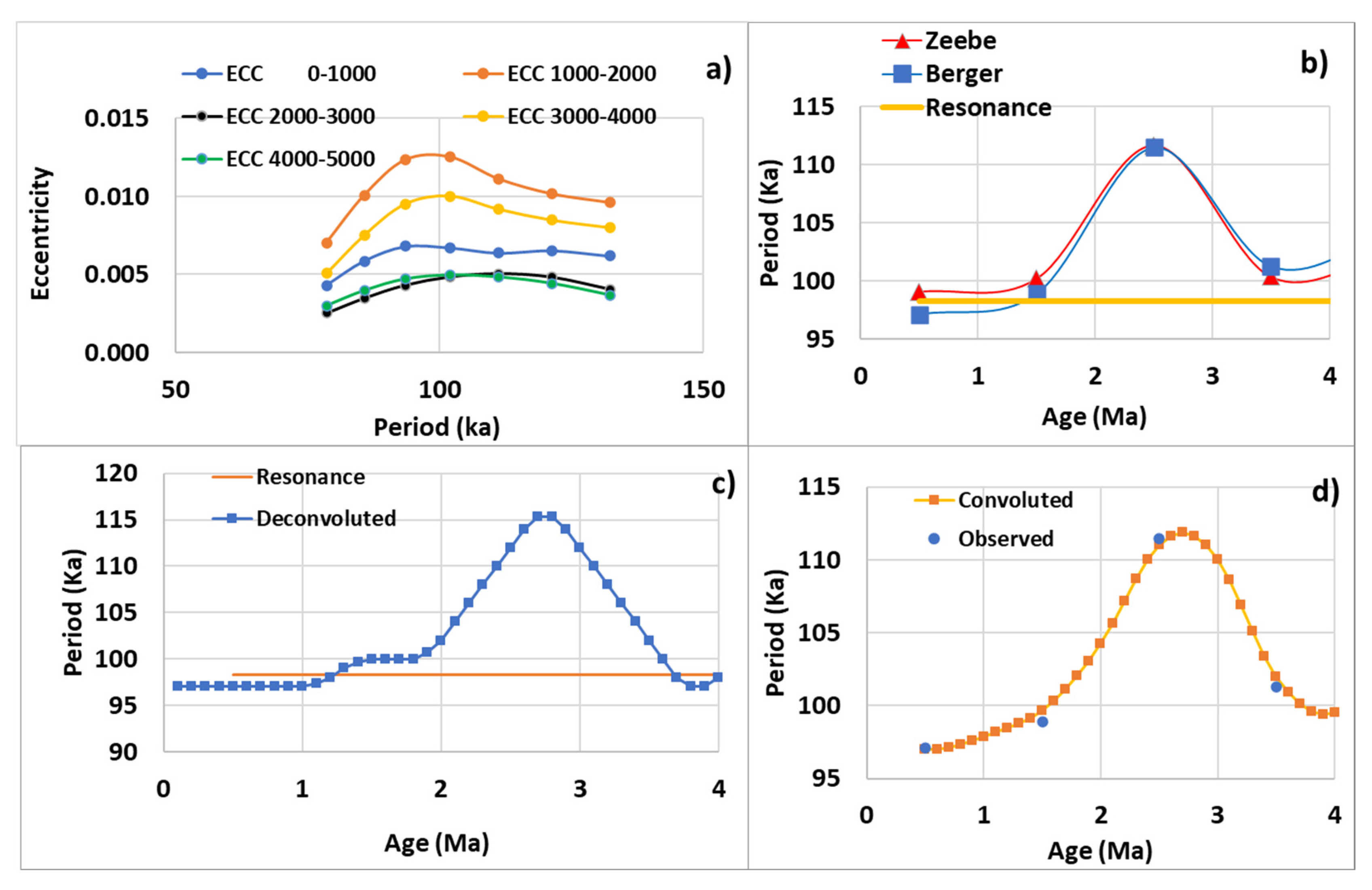
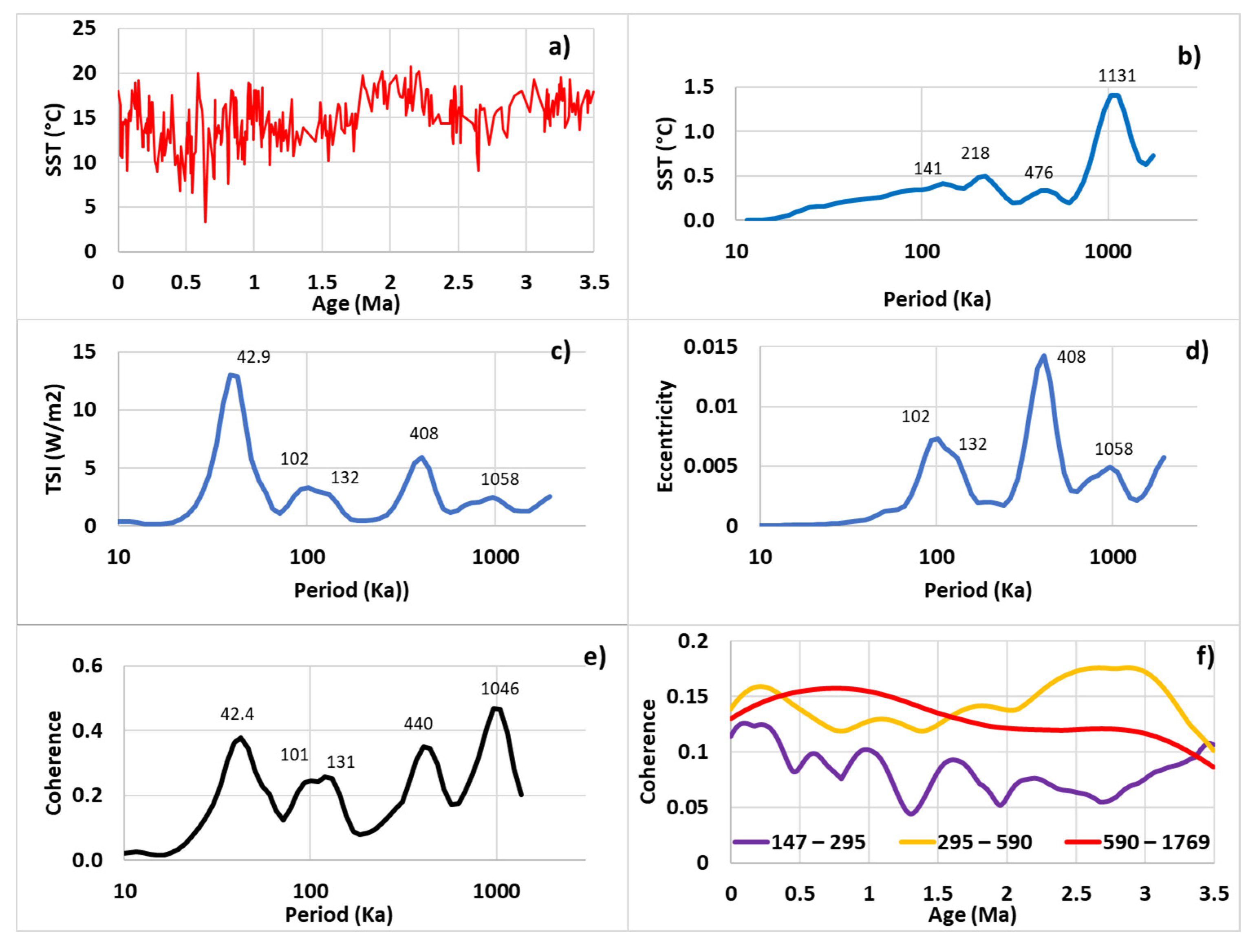
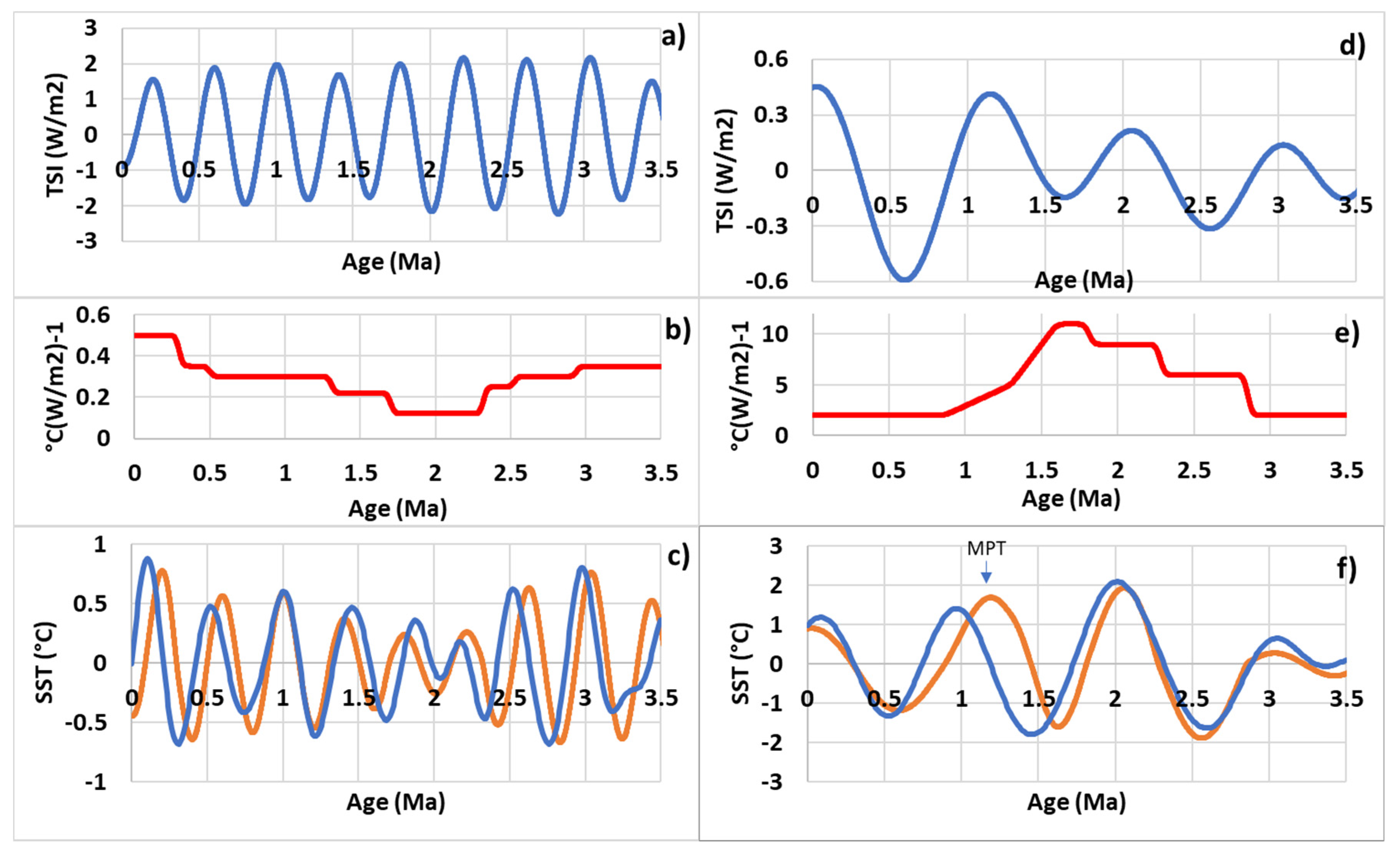

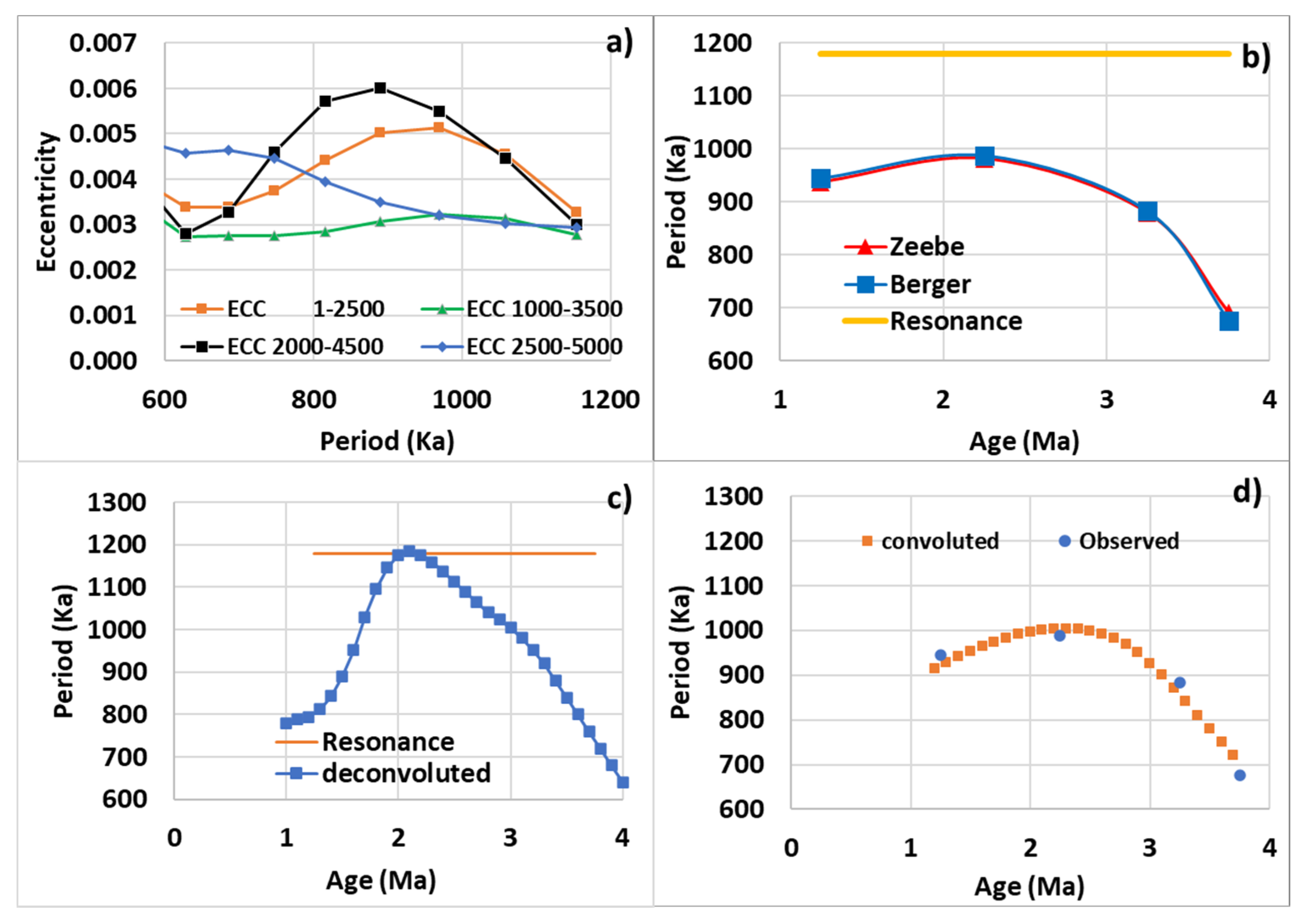


| Rank | Band Width (yr) | Period of Resonance (yr) | Subharmonic Mode | Forcing Mode |
|---|---|---|---|---|
| 12 | 147,456–294,912 | 196,608 | No external forcing | |
| 13 | 294,912–589,824 | 393,216 | Orbital forcing (eccentricity) | |
| 14 | 589,824–1,769,472 | 1,179,648 | Orbital forcing (eccentricity) | |
| 15 | 1,769,472–3,538,944 | 2,359,296 | No external forcing |
Publisher’s Note: MDPI stays neutral with regard to jurisdictional claims in published maps and institutional affiliations. |
© 2020 by the author. Licensee MDPI, Basel, Switzerland. This article is an open access article distributed under the terms and conditions of the Creative Commons Attribution (CC BY) license (http://creativecommons.org/licenses/by/4.0/).
Share and Cite
Pinault, J.-L. Resonantly Forced Baroclinic Waves in the Oceans: A New Approach to Climate Variability. J. Mar. Sci. Eng. 2021, 9, 13. https://doi.org/10.3390/jmse9010013
Pinault J-L. Resonantly Forced Baroclinic Waves in the Oceans: A New Approach to Climate Variability. Journal of Marine Science and Engineering. 2021; 9(1):13. https://doi.org/10.3390/jmse9010013
Chicago/Turabian StylePinault, Jean-Louis. 2021. "Resonantly Forced Baroclinic Waves in the Oceans: A New Approach to Climate Variability" Journal of Marine Science and Engineering 9, no. 1: 13. https://doi.org/10.3390/jmse9010013
APA StylePinault, J.-L. (2021). Resonantly Forced Baroclinic Waves in the Oceans: A New Approach to Climate Variability. Journal of Marine Science and Engineering, 9(1), 13. https://doi.org/10.3390/jmse9010013





